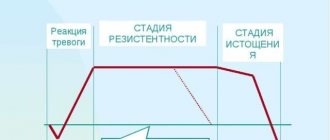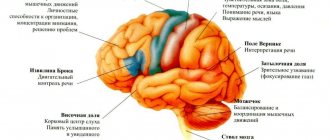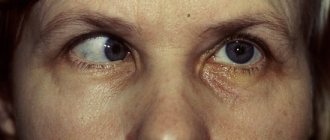Stress is good and bad: we understand the types and stages of development
In fact, stress helps our body; it is a natural mechanism that triggers the process of adaptation to any internal and external changes.
For example: You cut your finger - you experience stress, which makes your body understand that it’s time to leave the rescue team to heal the wound. or you have flown to a tropical country - stress tells the body what and how to change in order to more easily endure the heat and humidity.
However, stress can develop into a permanent state and then it becomes dangerous for your entire health and normal life.
Stress can be of two types: positive and negative.
What is distress
The concept of distress implies destructive stress that negatively affects the body over a long period of time . Under the influence of this condition, a person’s will and consciousness are suppressed, he loses the ability to adapt, the result is both social problems and health difficulties.
Stress in adults who are able to cope with it is a positive phenomenon in psychology. Such stress is called constructive - it is, in fact, an offer of change to a person. After nervous tension in a state of stress, a person relaxes and is emotionally discharged. The transition from stress to distress occurs when tension increases and there is no relaxation after it . This leads to constant spasm, where the body is tense and unable to relax.
Types of distress
Negative stress can be classified into different types depending on the area of causes that contribute to its occurrence.
- Physiological . Occurs with bodily problems. For example, in case of serious illness, hunger or malnutrition;
- Psychological . May occur in the presence of mental problems. These include phobias, complexes, illusory perception of the world;
- Nervous. Appears against a background of strong, prolonged internal tension, often accompanying neuroses.
By extent, destructive stress can be divided into:
- Acute, or short-term . Associated mainly with the immediate reaction of the body's defense systems. This is how the instinct of self-preservation reacts;
- Chronic . A state of distress characterized by prolonged nervous tension.
There is also a separate section in psychology: didactogenies (didactogenic states, neuroses) - this is the name given to childhood (school) distress caused directly by the educational system. These include:
- Emotional distress . The characteristic and most important feature is increased anxiety, heightened emotions in relation to success, results, or vice versa – to failures;
- Exam distress (stress of receiving a grade);
- Information-temporal distress . Appears due to overload, requiring you to constantly rush to get everything done;
- Communication distress . Due to the teacher’s illiteracy in building relationships with the class or individual students;
- Frustration distress . Associated with the teacher’s lack of sensitivity and his unfair attitude towards the student.
Interesting fact
Our reaction to stress is associated, for the most part, not with the stressful situation itself and its strength, but with our sensitivity and susceptibility to it. There are high and low sensitivity thresholds. Low gives good resistance to stress. When high, the slightest stress factor can cause a violent and unpredictable reaction.
Phases of distress
The body's response to a stressful situation develops in stages; several successive phases can be distinguished:
- The initial phase is characterized by a state of fear , anxiety, and increased anxiety. At the first stage of development, the body’s resources are mobilized in order to cope with the negative impact as soon as possible;
- The next phase is denial . During this period, the person closes off emotionally, trying not to think about the problem;
- The last phase is resistance . It is at this time that, independently or with the help of others, tactics of behavior and options for resolving the situation are developed.
The development of distress corresponds precisely to the last phase, or more precisely, to disruptions in its passage . In case of incorrect assessment and prediction of the development of a situation, a person takes the wrong ways to solve it. This makes it difficult to cope with the problem, nervous tension increases, and the body’s resources come to an end. As a result, nervous exhaustion occurs and somatic disorders develop.
More than 9,000 people have gotten rid of their psychological problems using this technique.
What not to do in a stressful situation:
- Panic. Panic prevents a person from correctly assessing the situation; a person is unable to confidently and consistently move towards solving the problem;
- Show aggression. It’s not for nothing that they say: “Anger blinds the eyes.” Anger is not conducive to rational thinking;
- Act primitively or childishly (be offended, feel sorry for yourself, try to get away from the problem);
- Obsess over what is happening. The “cloudedness” of the view prevents you from rethinking the issue from different angles to find a possible solution;
- Begin to depend on the problem. A way out can be found from any situation. Situations on which your life truly depends are extremely rare.
3. Diagnosis of acute respiratory distress syndrome
There are no specific tests to diagnose acute respiratory distress syndrome. The doctor usually performs a general examination
and listens to the heart and lungs with a stethoscope.
characteristic breathing
will be heard - wheezing, with crackling sounds.
When there is low oxygen in the blood, the skin and lips may take on a bluish tint. An arterial blood test can be done to check your blood oxygen levels.
.
In some cases where ARDS is suspected, general tests
:
- Chest X-ray
, which will help ensure that there is no fluid in the air spaces of the lungs; - Complete blood count
and other blood tests to detect signs of infection; - Sputum testing
to detect the presence of bacteria or fungus in mucus released from the lungs when coughing; - Computed tomography (CT) scan to look for fluid in the lungs, signs of pneumonia, or to diagnose other lung problems.
About our clinic Chistye Prudy metro station Medintercom page!
Causes of distress
The causes of distress vary widely. They can be united by one definition - psychotrauma. At the same time, it is almost impossible to name situations that are known to cause harm to a person, since everyone’s psychological characteristics are different. The body's stress response is influenced by attitudes toward life, values, beliefs, and the tendency to interpret events in a certain way. However, there are some factors that in most cases cause chronic distress:
- A person is unable to satisfy his primary physiological needs (according to Maslow’s pyramid of needs: hunger, thirst, reproductive instinct, etc.)
- Health problems (long-term serious illness, chronic pain, injuries requiring long-term recovery);
- A person is constantly accompanied by situations that evoke sharply negative emotions;
- Serious losses (death of loved ones, separations, divorces);
- Long-term restrictions in anything (limitation of freedom, forced rehabilitation measures in case of injuries and illnesses, diet or smoking cessation);
- Financial difficulties (lack of money, lack of work, debts);
- Major life changes (marriage, having children, moving);
- Family difficulties (conflicts with life partner, children, parents);
- Complete absence of any stress factors. In this case, distress is caused by a lack of goals and aspirations in life.
It is also interesting that another condition for the development of a long-term state of distress is the number of stressful situations over a certain time period. Moreover, it is easier to deal with one major trouble than with a bunch of minor problems.
4. Treatment of the disease
Typically, people who develop ARDS are already in a fairly serious condition and are most often treated in a hospital. And, as a rule, acute respiratory distress syndrome requires resuscitation measures
.
There is actually no specific treatment for ARDS. The goal is to support the patient's respiratory function
and allow the lungs to recover.
This may involve the use of ventilators
or
oxygen injection into the lungs
. Currently, scientists are developing new methods of maintaining the lives of patients with ARDS. And, for example, it was found that the operation of conventional mechanical ventilators, which creates air flow, reduces the mortality rate of patients with ARDS and allows them to begin breathing on their own faster and abandon ventilators.
In addition to maintaining breathing, treatment for ARDS includes combating the underlying cause of the pathology.
. For example, if a patient is diagnosed with a bacterial infection, antibiotics are usually prescribed. Because patients are usually unable to feed themselves during therapy, fluids and nutrients are administered to the body through IVs and tubes.
Outlook for patients with ARDS.
As already mentioned, ARDS is a life-threatening condition. It is worth noting that the survival rate of people with ARDS has increased in recent years. While some recover completely from the disease, others experience long-term breathing problems and chronic lung damage.
Usually bad forecasts
associated with some unfavorable factors:
- Progressive cancer;
- Advanced age of the patient;
- Sepsis (bacterial blood infection);
- Long-term alcohol abuse;
- Chronic liver diseases;
- HIV infection;
- Multiple organ damage;
- Organ transplantation.
Full recovery from ARDS can take several months or even years. Pulmonary rehabilitation
is an important part of the recovery program. A good pulmonologist will definitely tell you how to restore normal lung function. And, of course, periodic examinations by a pulmonologist are necessary to assess the condition of the lungs and adjust the course of rehabilitation.
Symptoms
Signs of distress that is acute, that is, occurring suddenly for unforeseen reasons, are difficult to miss. Most often they manifest themselves as somatic reactions, depending on the physiological characteristics of the body:
- Pressure surge;
- Ragged and rapid breathing;
- Blood drains from the skin, causing pallor or red spots to appear;
- Chills, trembling in the hands, in the body;
- Sweating;
- Nausea;
- Pain in the head, heart, muscles.
Symptoms of chronic distress can also be recognized with sufficient observation. These include the following changes:
- A person’s taste habits and appetite change;
- Bad habits appear or intensify;
- Interest in activities that previously brought pleasure fades away. An example is refusal of sexual relations, communication, hobbies, sports;
- Everyone's inherent desire to improve something in their life is lost. The person becomes apathetic, passive, loses his sense of humor;
- From the nervous system, symptoms such as problems with sleep and memory appear. A person begins to worry and fuss over trifles, become nervous, irritable, absent-minded;
- Speech changes for the worse, previously existing problems worsen, slurring, stuttering, and filler words appear;
- Thinking abilities decrease, as attention becomes unstable and focused on the problem.
Possible consequences of chronic distress include:
- Development of neuroses and psychoses;
- Alcoholism, drug addiction;
- Cardiovascular diseases;
- Ulcerative diseases of the gastrointestinal tract.
Eustress and distress - what's the difference?
There is also such a thing as eustress, that is, “good stress.” This word has two meanings: the experience of positive emotions and mild stress that mobilizes the body’s strength. This condition is also called constructive stress. Despite its positive impact, it should be limited. This can be compared to fire: if it is controlled and not allowed to increase in size, it warms, otherwise it destroys everything it touches.
Eustress causes a surge of strength, high spirits, a desire to act, and awakens a strong interest in life. At the same time, eustress is not always perceived positively by a person, especially by those people who are prone to a passive existence.
Diagnostics
In psychology, there are a number of tests that allow you to independently diagnose the level of stress, depression and anxiety. The main ones:
- L. Reader's test. Determination of the level of psychosocial stress;
- Beck Depression Inventory;
- Spielberger and Hanin test. Assessment of the level of reactive and personal anxiety;
- Sheehan Anxiety Scale. Help in diagnosing anxiety disorders.
All these tests are quite simple and straightforward. With their help, you can assess your condition and decide whether you need specialist help.
Eustress state
While in this state, a person experiences a loss of balance. At the same time, he has certain resources (material, mental, ethical, moral, life experience, knowledge base, etc.) in order to solve the tasks assigned to him. As a rule, the state of eustress is short-lived; during it, the “shallow” adaptive reserves of the personality are actively lost. This is manifested by problems in communication (speech is confused, a person cannot clearly formulate and express his thoughts), temporary memory lapses, somatic reactions (short-term darkening of the eyes, a rush of blood to the skin, rapid heartbeat, etc.). But at the same time, the mental functions of the individual (memory, thinking, imagination) and the physiological functions of the body proceed much better. With eustress, a person feels a rise in internal strength.
Treatment and prevention
Until distress has acquired a clinical form that requires the help of a specialist and medication, there are quite a large number of methods of self-treatment:
- Organize yourself a good sleep, go to bed not during the day, but at night, always before midnight. Eliminate interfering factors, sleep at least 7-8 hours;
- Walk and relax in the fresh air more often;
- Engage in non-exhaustive sports; excessive physical activity in a state of distress is contraindicated;
- Practice proper relaxation. Do yoga, meditation, breathing exercises. Massage will help a lot;
- Adjust your diet towards healthy nutrition, give up stimulants, strong tea, coffee;
- Give vent to the negativity. Choose the best method for yourself: hit a pillow or punching bag, scream in the forest or in the field, break dishes;
- Don't focus on the problem. Take time for something else, choose an activity that will distract you. Works that require full concentration are well suited: pottery, carpentry, drawing;
- The solution often comes when you say the things that are bothering you out loud. Discuss your problem with a loved one. Sometimes an outside perspective can help you find a non-trivial solution.
Prevention of distress is individual in each case, since its causes are always subjective. We can only give some general recommendations:
- Before rushing into any adventures, assess whether there are prospects, consult with others;
- Consider your problems from a rational perspective, without complaints or accusations;
- Adequately evaluate yourself, your abilities, and the capabilities of your body. You should not take on obviously impossible obligations;
- Learn to stop and take a break. Even ten minutes a couple of times during the working day is enough. Relax on the weekend. The body's resources are not unlimited, constant work will undermine your strength, and in the end, due to fatigue, you will do less than you intended;
- Accept your mistakes as learning experiences. Analyze, find reasons, try to draw conclusions so as not to get into similar situations in the future.
Regular release of accumulated tension is very important for prevention . Everyone chooses a convenient and socially acceptable way. Use as many senses as possible. Eat well, rest, take vitamins. All this will help the body recover and prepare for inevitable new stress.
If you don’t want to give up and are ready to really, and not in words, fight for your full and happy life, you may be interested in this article .
Stress, distress, eustress
The famous physician and world-famous biologist, as well as the director of the International Institute of Stress in Montreal, Hans Selye, proposed to distinguish between such polar functions of stress. It was he who introduced additional concepts: eustress and distress. Stress itself is an important mechanism for the body to resist adverse external influences. Also, under the influence of eustress, maximum mobilization of the individual’s internal resources occurs. But distress is, of course, a harmful state for a person. The word itself is translated as “misfortune”, “exhaustion”. Selye later, after years of research, wrote a book called Stress Without Distress. In it, he describes in detail the essence of the biological concept of stress and proposes a so-called code of morality, or a code of conduct, following which you can maintain a normal level of stress, realize your natural potential, and express your “I”.
Thus, a tense state that activates and mobilizes the body’s forces is called stress. This is all clear. What is distress? This condition is characterized by excessive stress, in which the body is unable to adequately respond to environmental demands.
Consequences
Naturally, this state of health does not bring benefits. Tension during distress becomes very strong, excessive fussiness and inhibition appear. It is difficult for a person to manage attention; he is distracted by any little things that begin to irritate him. He often fixates his attention too much on something. When solving a problem, a person cannot find a way out and gets fixated on it for a long time. Memory deterioration also occurs with distress. Even after reading a simple text several times, a person cannot remember it. Deviations in speech also develop: the patient “swallows” words, stutters, and the number of interjections and filler words increases. The quality of thinking deteriorates, only simple mental operations are preserved during distress. A narrowing of consciousness occurs: the patient stops responding to humor. It is not recommended to joke with a person in this state - he simply will not understand the joke.









